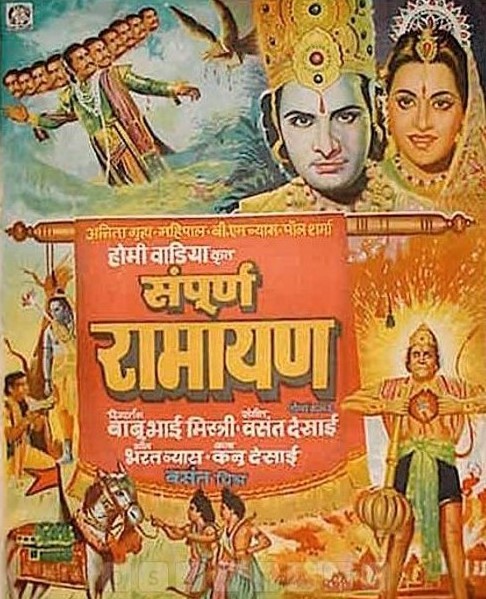 This Hindi language oddity from 1961 is what is known in its native India as a Devotional Film. Inspired by the Hindu epic RAMAYANA by Valmiki, it’s one of several filmings of the tale to appear in India, following a similarly titled Hindi language film in 1933, a Telugu language version from 1936 and the same year’s RAM RAJYA. A Tamil SAMPOORNA RAMAYAM appeared in 1956, a Telugu version in 1972 and another Hindi version in 1973, along with the Bengali language RAMAYAN from 1980, the Hindi SAMPOORNA RAMAAYAN in 1996 and the same year’s Telugu language RAMAYANAM. That’s in addition to the numerous RAMAYAN TV series, from 1987, 2002, 2008 and 2012. And that, believe it or not, is but a partial listing of the many adaptations of Valmiki’s masterpiece.
This Hindi language oddity from 1961 is what is known in its native India as a Devotional Film. Inspired by the Hindu epic RAMAYANA by Valmiki, it’s one of several filmings of the tale to appear in India, following a similarly titled Hindi language film in 1933, a Telugu language version from 1936 and the same year’s RAM RAJYA. A Tamil SAMPOORNA RAMAYAM appeared in 1956, a Telugu version in 1972 and another Hindi version in 1973, along with the Bengali language RAMAYAN from 1980, the Hindi SAMPOORNA RAMAAYAN in 1996 and the same year’s Telugu language RAMAYANAM. That’s in addition to the numerous RAMAYAN TV series, from 1987, 2002, 2008 and 2012. And that, believe it or not, is but a partial listing of the many adaptations of Valmiki’s masterpiece.
The film begins with the fetching Sita, who decides to have a Svayamvara (a lavish ceremony held by a highly placed woman to choose her groom) in which several prospective suitors are challenged to lift and string the unliftable bow of Shiva. The dashing Lord Rama, the prince of Ayodhya, handily manages the feat. Rama, however, is banished from Ayodhya due to his stepmother Kaikayi, who wants Rama’s half-brother Bharat to become the king.
Sita insists on accompanying Rama in his exile, and upon their defection the kingdom is plunged into despair, with Rama’s father literally dying from grief. Bharat is none too happy with the situation and tries to convince Rama to return, but he refuses.
More trouble occurs in the form of Rama’s evil brother Lankesh, whose wife attempts to seduce Rama. When he rejects her advances, and cuts off the end of her nose with a magic arrow, Lankesh becomes determined to get revenge. This is accomplished by having the demon Mareech take the form of a deer with a golden hide, which distracts Rama long enough that Lankesh is able to snatch Sita up.
Rama sends his devoted companion Hanuman, a half man-half monkey, to Lankesh’s palace to inform Sita that Rama is planning on sending an army of apes to rescue her. Rama’s ape army builds a massive stone wall across the ocean, upon which Rama is able to cross into Lankesh’s kingdom and fell him. Thus Rama is reunited with Sita, and lords over an ape populace.
But this idyllic state of affairs comes crashing down after a washer man shuns his wife for being unfaithful, which leads to the populace coming to distrust Sita. Thus Rama, acceding to the public will, has to abandon her. Twelve years pass; Sita, living in the forest, births two Rama-sired sons, Luv and Kush, while her companion, an old guy named Valmiki, writes an epic poem, the RAMAYAN, about Rama’s exploits.
Boiling Hindi religious texts down to a two—or in this case three—hour narrative is no easy task. It’s a challenge that has defeated the makers of quite a few devotional films, which have a tendency to be incoherent (see the deadening SHREE GANESH) or excessively drawn-out (as in the 1980s-era MAHABHARAT and RAMAYAN miniseries, both of which clock in at around 80 hours), but SAMPOORNA RAMAYAM is a colorful, well-paced and entertaining spectacle.
Being a Hindi film, it’s marked by patently artificial stage-bound sets and overheated-to-the-point-of-insanity melodrama, with lots of impassioned declarations of love/honor/devotion (“O mother earth, by giving birth to me you made my life worthy”…“O clouds, pour out as a proxy to the tears in my eyes!”). Also in keeping with their nationality, the proceedings are packed with copious song and dance numbers that usually involve David Lean worthy crowds, dressed in an assortment of multi-hued garments. The special effects are outrageously primitive but extremely copious, seeing as how the characters are able to fly, shapeshift and read minds.
The narrative is a bit overstuffed, requiring copious off-screen singers and narrators to explain things. Its major flaw is the impossibly virtuous, invincible and all-knowing protagonist, who is literally too good to be true (whereas the treatment of the female characters can be construed, correctly, as misogynistic).
Also contained herein are a wealth of imaginative touches like the sight of Rama’s vices—lust, anger, ego, greed, etc.—represented by having his head literally multiply and argue with its fellows. Technically the film leaves a great deal to be desired, but it has ingenuity and inspiration to spare.
Vital Statistics
SAMPOONA RAMAYANA
Basant Pictures/Wadia Brothers Production
Director: Babubhai Mistry
Screenplay: Vishwanath Pande, C.K. Mast
Cast: Mahipal, Anita Guha, Sulochana Latkar, Lalita Pawar, Helen, Achala Sachdev, Krishna Kumari, Raj Kumar, Anand Kumar, Uma Dutt, Badri Pasad, B.M. Vyas, Pal Sharma, Sushil Kumar, Shribhagwan, Kate, Sinha
